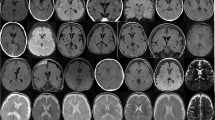Summary
A medico-legal autopsy case of hydranencephaly in a male infant which was first suspected of maternal infanticide is reported. The infant was 48cm in height, weighed 2.86kg and the circumference of the head, the chest and the abdomen was 32.2cm, 31.0cm and 30.4cm, respectively, with no deformities of the head or body. Autopsy examination, however, revealed a severe defect in the central nervous system. The cranial cavity was filled with a cloudy dark red fluid (ca. 310ml) instead of the cerebral hemispheres. The residual central nervous tissues were mostly subtentorial structures from the midbrain to the spinal cord namely, corpus mamillare, corpora quadrigemina, corpus pineale, crus cerebri, pons, cerebellum, medulla oblongata and spinal cord. The basal ganglia, thalamus, hypothalamus and chiasma opticum could not be found, although atrophic hypophysis, eyeballs and optic nerves were present. The usual distribution of cerebral blood vessels, especially the branches of the anterior and middle cerebral arteries and Willis' ring, was absent despite the presence of the internal and external carotid arteries. Other organs were, in general, congestive. The marked cortical atrophy of the adrenal glands (left 0.5g, right 0.6g), especially the zona fasciculata, was characteristic. The hydrostatic lung test gave partially positive results, but this was considered to be due to artificial respiration by an ambulance man because amniotic fluid components were microscopically noted and fully expanded alveoli were not found. In conclusion, the cause of the infant's death was diagnosed as stillbirth due to aspiration of amniotic fluid caused by the severe defect of vegetative hypothalamic function through hydranencephaly.
Zusammenfassung
Ein Fall einer rechtsmedizinischen Obduktion an der Leiche eines männlichen Kindes mit Hydranencephalie wird beschrieben, in welchem zunächst der Verdacht einer Kindstötung bestand. Das Kind war 48cm lang und 2,86kg schwer, die Umfänge des Kopfes, des Brustkorbs und des Abdomens waren 32,2cm, 31,0 cm, und 30,4cm. Kopf mit Körper waren normal geformt. Die Obduktion deckte jedoch einen schweren Defekt des Zentralnervensystems auf. Die Schädelhöhle war mit einer trüben, dunkelroten Flüssigkeit (ca. 310 ml) ausgefüllt. Die Gewebsreste des Zentralnervensystems waren überwiegend subtentoriale Strukturen des Hirnstamms, speziell Corpus mamillare, Corpora quadrigemina, Corpus pineale, Crura cerebri, Pons, Cerebellum, Medulla oblongata und Rückenmark. Die Basalganglien, Thalamus, Hypothalamus und das Chiasma opticum konnten nicht gefunden werden, obwohl eine atrophische Hypophyse sowie Augenbulbi und Sehnerven in den Augenhöhlen vorhanden waren. Die normale Verzweigung der cerebralen Blutgefäße, speziell der Äste der vorderen und mittleren Cerebralarterien und des Circulus arteriosus Willisi, fehlten trotz Vorhandensein der Arteriae carotides internae et externae. Andere Organe waren im allgemeinen gestaut. Die ausgeprägte Rindenatrophie der Nebennieren (links 0,5g, rechts 0,6g), spezielle der Zona fasciculata, war charakteristisch. Die Lungenschwimmprobe gab teilweise positive Resultate, dies war jedoch die Folge einer künstlichen Beatmung durch einen Mann des Rettungsdienstes zu erklären, weil Fruchtwasserbestandteile mikroskopisch festgestellt und vollständig entfaltete Alveolen nicht gefunden wurden. Im Resultat wurde eine Totgeburt des Kindes diagnostiziert. Todesursache war die Aspiration von Amnionflüssigkeit, verursacht durch einen schweren Defekt der vegetativen hypothalamischen Funktion infolge Hydranencephalie.
Similar content being viewed by others
References
Swaiman KF, Jacobson RI (1984) Developmental abnormalities of the central nervous system. In: Baker AB, Baker LH (eds) Clinical neurology, vol. 4, revised edn. Harper and Row, Philadelphia, Chap. 55
Halsey JH Jr, Allen N, Chamberlin HR (1971) The morphogenesis of hydranencephaly. J Neurol Sci 12:187–217
Friede RL (1989) Developmental neuropathology, 2nd edn. Springer, Berlin Heidelberg New York, pp 28–43
Ueda M, Ishida N, Hamana S, Egi H (1958) A case of hydranencephaly - an autopsy case suspected of an infanticide. Jpn J Leg Med 12:839–849
Investigation Committee of the Medico-Legal Society of Japan (1992) Reports on medico-legal data from the massive investigation performed by the medico-legal society of Japan - Weight and size of internal organs of normal Japanese today. Jpn J Leg Med 46:225–235
Spielmeyer W (1905) Ein hydranencephales Zwillingspaar. Arch Psychiatr Nervenkr 39:807–819
Escourolle R, Poirier J (1978) Manual of basic neuropathology, 2nd edn. Saunders, Philadelphia, pp 178–181
Lange-Cosack H (1944) Die Hydranencephalie (Blasenhirn) als Sonderform der Großhirnlosigkeit. I. Anatomischer Teil. Arch Psychiatr Nervenkr 117:1–51
Lange-Cosack H (1944) Die Hydranencephalie (Blasenhirn) als Sonderform der Großhirnlosigkeit. II. Klinischer Teil. Arch Psychiatr Nervenkr 117:595–640
Myers RE (1969) Brain pathology following fetal vascular occlusion: an experimental study. Invest Ophthalmol 8:41–50
Altshuler G (1973) Toxoplasmosis as a cause of hydranencephaly. Am J Dis Child 125:251–252
Weinstein L (1982) Syndrome of hemolysis, elevated liver enzymes, and low platelet count: a severe consequence of hypertension in pregnancy. Am J Obstet Gynecol 142:159–167
Deane HW, Greep RO (1946) A morphological and histochemical study of the rat's adrenal cortex after hypophysectomy, with comments on the liver. Am J Anat 79:117–146
Author information
Authors and Affiliations
Rights and permissions
About this article
Cite this article
Ohshima, T., Kondo, T., Lin, Z. et al. Suspected maternal infanticide in a case of hydranencephaly. Int J Leg Med 105, 351–354 (1993). https://doi.org/10.1007/BF01222120
Received:
Revised:
Issue Date:
DOI: https://doi.org/10.1007/BF01222120
Key words
- Infant death
- Hydranencephaly
- Suspected maternal infanticide
- Stillbirth
- Malfunction of vegetative hypothalamus




